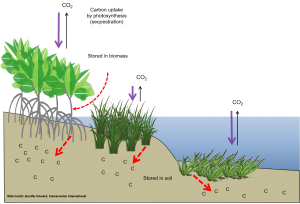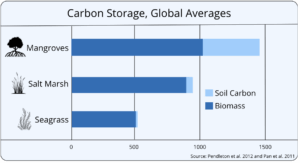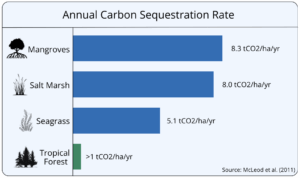Blue Carbon Science
Carbon Stored and Sequestered by Coastal Wetlands

Carbon is held in the above and below ground plant matter and within wetland soils. As plants grow, carbon accumulates annually and is held within soils for centuries. Science is increasing our understanding of how much carbon is sequestered (captured from the atmosphere via photosynthesis) and stored by wetlands.
Blue Carbon ecosystems – seagrass beds, mangroves, salt marshes, and other tidal wetlands – capture atmospheric carbon and store it in the ground at rates up to 10 times greater than forest on a per area basis. In forest habitats, the majority of carbon storage is in the above-ground plant material (think woody biomass). In contrast, the majority of carbon storage in wetlands occurs in the soils, where it can remain locked up for centuries or more1.
As plants grow, they capture atmospheric carbon dioxide and convert it into biomass such as leaves, stems, or roots. That carbon can then either be lost to the atmosphere through respiration or accumulate in the soil through the burial of dead plant parts.
Why are wetlands soils such great carbon sinks? Because wetland soils stay wet, oxygen content in the soil is low. Lower oxygen means decomposition happens much more slowly, allowing organic material to build up over time. As long as these soils remain intact and wet, carbon remains locked up – making wetland soils amazing long-term carbon sinks!
When coastal wetlands are drained or degraded, the stored carbon can re-oxidize, releasing back into the atmosphere relatively quickly – sometimes releasing centuries worth of stored carbon in only a few decades. Protecting our remaining coastal wetlands also protects these large carbon stores, while continuing to provide many other benefits (improved water quality, storm protection, fisheries habitat, etc.) An estimated half a billion tons of CO2 are released every year due to wetland degradation and drainage – roughly equivalent to the 2008 emissions of Japan.
1Sources: E. Pidgeon. 2009. Carbon sequestration by coastal marine habitats: important missing sinks.
Carbon Storage
The largest store of carbon in wetland habitats is in the soil. In the first meter of soil, they contain:
- Seagrasses: 512 Mg CO2e/ha
- Salt marsh: 917 Mg CO2e/ha
- Mangroves: 1,028 Mg CO2e/ha
Carbon Sequestration
Wetland plants regularly remove CO2 from the atmosphere and sequester it in the form of soil carbon, where it can remain for centuries. Average carbon sequestration rates are several times greater than for forests:
- Seagrasses: 138 ± 38 gC/m2/yr equal to 5.1 tCO2/ha/yr
- Salt marsh: 218 ± 24 gC/m2/yr equal to 8.0 tCO2/ha/yr
- Mangroves: 226 ± 39 gC/m2/yr equal to 8.3 tCO2/ha/yr
Carbon Comparisons
- A Hummer driving 15,000 miles emits 11 tons of CO2e (carbon dioxide equivalents).
- A Prius driving 15,000 miles emits 3.7 tons of CO2e.
- While just one hectare (2.5 acres) of salt marsh removes an estimated 8 tons of CO2e every year.


